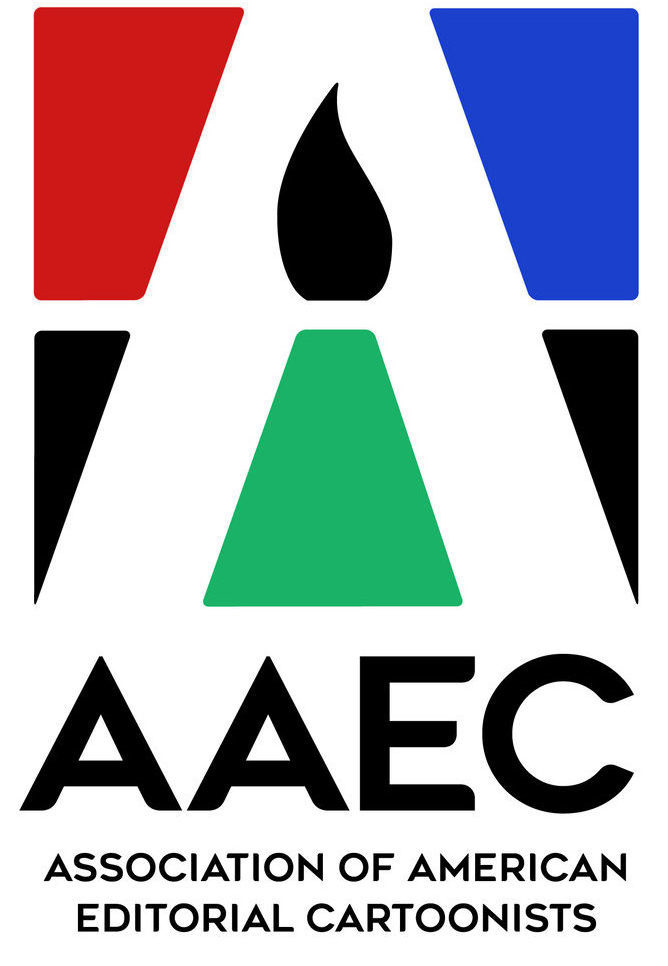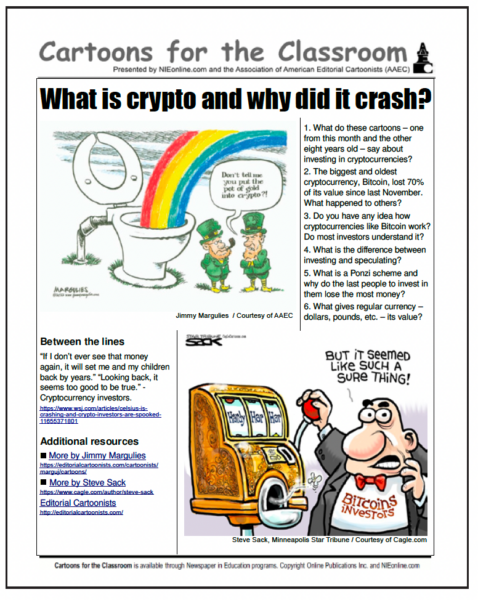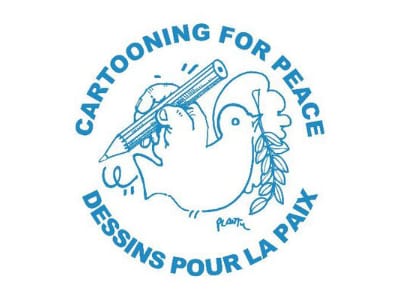As
our current model collapses around us — whether it is a business model,
employer model or, in the case of the AAEC, convention sponsor model — the
debate on what to do next grows louder. While no one’s figured out a
solution yet, at least we’re talking about it. Here are two recent discussions,
one an exchange between Tom Spurgeon and Ted Rall on The Comics Reporter
blog, the other a column by Daryl Cagle. —JP
Never
Say Die: IS There an Argument That Works?
And They Will
All Live Like Cartoonists: The US Economy And Comics, Post #26 [March
3, 2009]
The cartoonist
and current AAEC president Ted Rall release[d] another editorial [today]
about the stupidity of newspapers in dumping their editorial cartoonists.
I’ll repeat what I said after the last one of these jeremiads: it isn’t
good enough. The decline of staffed editorial cartooning positions is beyond
the point where a bunch of strong assertions cleverly made and presented
with passion will convince newspapers that what they’re doing isn’t necessary.
I don’t see anything here that would convince me as a newspaper editor
I wouldn’t be better off simply picking up a syndicated Ted Rall cartoon
or taking my staff cartoonist investment and hiring a video blogger. Once
again, I challenge Ted Rall and the AAEC to come up with five models of
newspaper-cartoonist relationships that work for those newspapers, specific
examples and detailed reasons why they work, and how newspapers can develop
that within their own publications. Having not one but two skilled cartoonists
sure didn’t save the Rocky Mountain News. Fair or not, that’s the tenor
of the conversation right now.
—Tom
Spurgeon, The Comics Reporter
Ted Rall Responds
To My Charge That Better Arguments Are Needed On Behalf Of Editorial
Cartoonists [March 5, 2009]
Ted
Rall: I
couldn’t agree more with you: the AAEC and other cartoonists organizations
need hard data that demonstrate the value of editorial cartoons, comics
and graphic arts to newspapers, online publications, etc. I have been
working toward that goal for several years within the AAEC. What is lacking
is money.
Yes, money.
Among other things, we need to hire a professional polling organization
to conduct a scientifically sound reader survey to study readers’
attitudes towards cartooning. Such surveys cost $20,000 or more — not that
much money objectively, but we’re a small organization and haven’t been able
to budget the funds. In short, it’s not that we don’t know what needs to
be done. The trouble is figuring out how to come up with the cash to do it.
You challenged
me to come up with five examples of newspaper-cartoonist relationships
that work. I could point to scores! The problem is that no cartoonist and
no newspaper wants to discuss the details of their businesses, including
the well-known fact within the business that editorial cartoons routinely
top out reader surveys conducted by papers, in a public forum. Why that
is varies — maybe it would make cartoonists uppity, or perhaps it’s proprietary
information and that’s reason enough to keep it secret. But it surely says
something that, even in the current regime of ferocious cost-cutting, the
vast majority of big-city major newspapers still employ a staff editorial
cartoonists. It’s not just because so many AAECers are so darned cute.
Anyway,
we need to do some polls to prove what we already know to be true: cartoonists
add a lot of value to their papers.
Tom
Spurgeon Responds: Ted, thanks
for responding. I appreciate your position, but I still have a hard time
believing that the only options here are very general exhortation or
specific, funded research results. There has to be some middle ground
in there somewhere. I hope that you’ll consider a qualitative approach
even if you can’t do a quantitative one. I know that there are dozens
of papers with editorial cartoonists, and it’s probably not because they’re
cute. On that level I guess they all work. But the trend is going the
other way, and I’d love to hear you get at more specific reasons why
even if you don’t have hard numbers. For you to say that you could point
to dozens of relationships that work is no doubt true; I could, too,
for as far as that goes. But 18 months ago that list would have included,
say, Chip Bok and Jim Borgman and their newspapers. It’s my hope that
we could hear from your organization in slightly less broad strokes than
implying everyone who disagrees with you is kind of a moron why, say,
Tom Toles is an asset worth keeping.
The Future of Syndication
By
Daryl Cagle
I was asked
to speak about the future of syndication on panels at the National Cartoonists
Society convention this week and the Association of American Editorial
Cartoonists convention in July. The subject is a burning issue for cartoonists — burning
a hole in the wallets of many cartoonists, as newspapers seem to be fading
away before our eyes.
The best-known
editorial cartoonists have always been the cartoonists with the biggest
list of syndicated client newspapers. Fifty years ago, when there were
two or three times as many political cartoonists and the newspaper industry
was thriving, newspapers would purchase individual subscriptions to star
cartoonists from syndicates that were like cartoon boutiques with exclusive
content. The cartoonist would mail his cartoon to his syndicate, who would
print the cartoon on paper and re-mail it to all of the subscribing newspaper
editors, in big envelopes stuffed with the other boutique, exclusive features
that each editor subscribed to and slowly received, days after the news
was fresh.
It would
have been difficult for a cartoonist to self syndicate in those days because
delivery and billing was a big job; there were efficiencies of scale for
the syndicates, who had ambitious printing, mass postal mailing operations
and sales forces that were constantly visiting editors.
In recent
decades the individual sales have given way to “packages” of groups of
cartoonists. It is cheaper and easier for an editor to subscribe to a group
of cartoonists, with one monthly invoice for the whole group, than to keep
track of individual subscriptions. By the 1980’s and 1990’s, competition
between the packages had driven the prices for editorial cartoons down
to alarmingly low levels, leading cartoonists to complain about the collapse
of their profession.
In fact,
it was almost impossible for a cartoonist to sell his own work to newspapers.
If an editor could subscribe to the Copley News Service package of twelve
great cartoonists for $24 per week, there was no sense in talking to an
individual cartoonist about subscribing to only his work for $2 per week.
The price for editorial cartoons had fallen so low that it would be embarrassing
for an editor to even discuss price with a single cartoonist.
I started
my little syndicate in 2000, at what seemed to be a terrible time, with
ugly low prices and disinterested, unmotivated editors in an oversaturated
market. But I had an edge; the other big syndicates were slow in transitioning
from postal mail delivery to e-mail delivery, and had no download Web sites
for their newspaper editors. I was the first to put up a nice download
site, where the cartoonists uploaded their own cartoons, and the cartoons
appeared immediately when they were drawn. We also delivered the cartoons
by e-mail, and I assembled a group of great cartoonists to compete as a
package, against the other packages. It worked and we built an impressive
list of over 600 newspaper subscribers in the first three years. (Today
we have about 900 subscribers.)
Now that
newspapers are failing, circulation is dropping, editors are cutting expenses
anywhere they can, and prices for editorial cartoons couldn’t fall any
lower, the future looks even bleaker for political cartoonists. A few years
ago it looked like the Internet would be our salvation. There are some
Web sites that are good customers, but sales to the Web have turned out
to be a disappointment. There is no culture of paying for content on the
Web. Advertising with content on the Internet pays a pittance. The Web
is a dud.
Many cartoonists
thought that animated editorial cartoons would be our future. The Pulitzer
committee certainly thought so, picking three animated editorial cartoonists
as winner and runners up recently when animated editorial cartoons were
on people’s minds. Some cartoonists do excellent work animating their cartoons,
but with a handful of exceptions, there is no business plan in it. No matter
how good the animated editorial cartoons are, they won’t work without clients
who will pay for them. Some cartoonists stubbornly cling to the idea that
animation will be our salvation. I wish them luck.
We’re now
seeing more cartoonists who are willing to work for free for Web sites,
with the idea that this will somehow lead to a paying job. As editorial
cartoonists are laid off from staff positions at declining newspapers,
they continue to draw cartoons in syndication as they did when they had
real jobs. Our profession seems to be transitioning into a hobby.
Ironically,
political cartoons are now more popular than ever. We have a big audience
for our Web sites. Cartoons still dominate newspaper editorial pages. Our
annual Best Political Cartoons of the Year books are popular. High school
and middle school kids have mandated state testing on political cartoons
in every state and teachers teach to the tests, forcing millions of students
to love our art form every night as they grind through their homework assignments.
The quality
of work that editorial cartoonists are doing now has never been better.
The product is great, the audience is there for the product, and the problem
is the business plan.
What
the Future Holds ?
We see two
big trends in our little business. First is the decline in newspaper clients — what
used to be the whole reason for drawing editorial cartoons.
Second,
we’re seeing growth in strange, oddball subscribers. Our new subscribers
and pay per use customers come from all over the globe, like Southeast
Asia, Arab countries, Eastern European countries, places we would never
expect. And they are all different kinds of companies, including foreign
newspapers, magazines, newsletters, book publishers, TV stations and oddball
Websites. These are customers who find us because we’re easy to find on
the Web (search Google for “political cartoon” or “editorial cartoon” and
we come up first). Most new customers are overseas, their numbers are growing
and there are enough of them to make up for our losses in newspapers, keeping
our little business stable and making us optimistic about continued growth.
The new,
oddball customers have something in common. They don’t comparison shop,
they come to us and subscribe or purchase pay per use. They don’t know
anything about other online cartoon sources like stock illustration houses
or other syndicates, and they don’t care; we have enough content that they
can find something they like.
In the old
days syndicates knew just who to sell to — they all sold to the same list
of newspaper editors, in a limited market, so it made sense that each syndicate
had exclusive arrangements with their cartoonists, to differentiate their
content from their competitors. Now there doesn’t seem to be so much value
in exclusivity. A number of our cartoonists are non-exclusive and some
are sold in other online stores or are represented by other syndicates
— we’ve never heard from new clients who have noticed that.
It would
seem that the new paradigm is to think of a syndicate like a store. A store
in a good location has lots of customers who find the store. A store in
a poor location draws few customers. Stores in different locations draw
different customers.
Cartoonists
are like producers who create products to put in the stores. Cartoonists
should want their cartoons to be sold in as many different stores as possible,
because those stores now have different customers.
Exclusive
syndication deals now have less value to the syndicates and tie the hands
of the cartoonists. The new paradigm for editorial cartoonists is to be
resold in as many ways, in as many places as possible.
I think
this is a future that many cartoonists will find difficult to accept. Cartoonists
have always been drawn to the idea that a syndicate is a benevolent Mommy,
who will take care of all the nasty business stuff while they can concentrate
on their creative work; this is a model that hasn’t worked for most cartoonists
and is even worse now, but cartoonists keep coming back to it and keep
signing long term, exclusive contracts with old world syndicates.
From the
syndicate’s or “store’s” point of view, it means we need to find a way
of presenting our product to more, non-overlapping groups of customers
on the Web. We’ve looked at sublicensing our content to be sold by another
store, like Cartoonbank, but I think there is a basic problem with that.
Once we hit the point of having enough content so that a customer can easily
find a cartoon he likes, there is diminishing value to adding more content,
or cartoonists. Putting more content into a store that already has plenty
of content doesn’t make for more sales overall in that store. We need more
stores, in different wrappers, in different places, reaching more potential
customers in different ways. That’s our plan now.
I would
expect to see more cartoonists getting together to start their own online
stores and syndicates as I did — as Malcolm Mayes did with Artizans, and
as Sarah Thaves did with Cartoonistsgroup. The barriers to entry are low
in the Internet age. It won’t work for self-syndicating cartoonists to
call the same 1,500 daily newspapers who are sick of getting so many sales
calls, but I expect that more cartoonists will lay claim to bits of the
vast, odd and foreign client potential on the Web.
My advice
for 21st century editorial cartoonists is: draw a consistent, steady flow
of great cartoons that are not about local events, with a global audience
in mind. Sign non-exclusive deals with as many syndicates, online stores
and stock houses that you can find, around the world, and allow those
“stores” to sub-license your work through other “stores.” Have your own Web
site where your work is easily available to any customer who is interested
just in you, and publicize your site as best you can. Manage your work as
a database of all your work. Your product is all your work from past years,
not just what you’re drawing today; and when you join a new online store
or syndicate, bring all your past cartoons with you so that your archive
is easily accessible and can continue to generate sales of second rights.
Don’t accept long term contracts with syndicates, agents or online stores;
always be free to move. And don’t rely on anyone to take care of your career,
but you.












